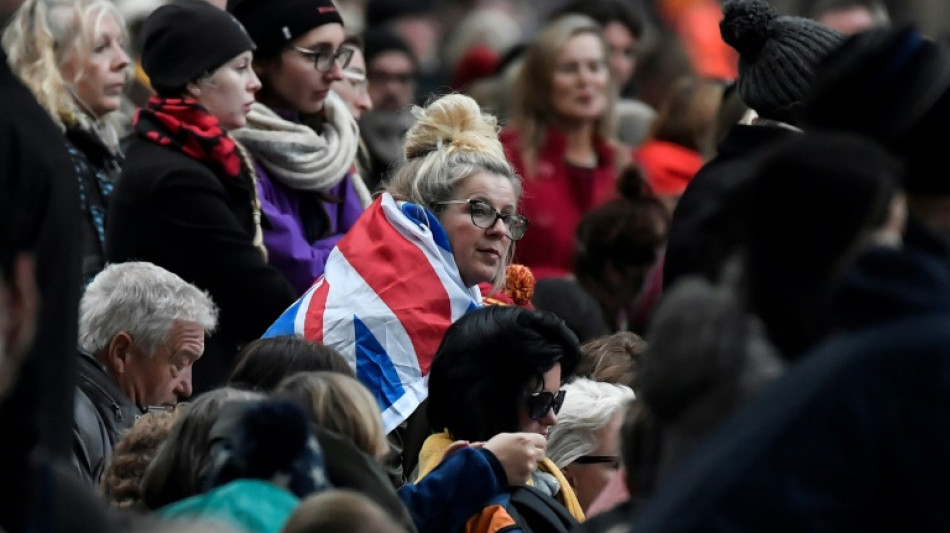

'Part of history': crowds jam London for queen's funeral
Huge crowds packed central London on Monday to watch the state funeral of Queen Elizabeth II as people from across the United Kingdom and beyond paid their final respects.
When dawn broke over the River Thames, well-wishers streamed out of Embankment underground station headed for the area around Westminster Abbey.
But many were already there, camping in sleeping bags behind the metal barriers along the Whitehall government district, where the funeral procession will pass.
"It's part of history," said Bethany Beardmore, 26, an accountant whose brother is a Grenadier Guard and part of the ceremonies.
"Not in my lifetime is there going to be another queen."
Beardmore arrived at 9:00 pm (2000 GMT) on Sunday but, fuelled by too much sugar and caffeine, found it impossible to sleep in the cold.
"Everyone was chatting," she said.
Former soldier Jamie Page, 41, served in the Iraq War and took a train from his home in Horsham, south of London, at 5:00 am.
"Sixteen years old, I swore an oath of allegiance to the queen," he said, his military medals glinting in the weak morning sun.
"She's been my boss. She means everything. She was like a gift from god."
Margaret McGee, 72, had arrived from Northern Ireland for the events in a small token of appreciation for the queen's long service and said she had met people from Liverpool, Scotland and Wales.
"She worked so hard all her life, devoted herself to the country," she said.
"She never gave up to the very end, she never had a retirement."
- Last to pay respects -
The queen's flag-draped coffin has been lying in state at parliament's Westminster Hall since Wednesday.
Hundreds of thousands are estimated to have filed past since then to pay their respects.
The doors to the hall were finally shut at 6:30 am to prepare for the coffin's transfer past Parliament Square to Westminster Abbey.
The last member of the public to pass through the hall was Chrissy Heerey, a serving member of the Royal Air Force.
"It feels amazing," she told AFP. "When they came to me and said, 'right, you're the last person', I said, really?"
Heerey, from Melton Mowbray near Leicester in central England, had queued through the night but was also joining the crowds for the procession.
"A long day but very well worth it. It's nothing compared to what the queen has done for the country," she added.
After the funeral service, the coffin was to be taken on a gun carriage in procession past Buckingham Palace to a hearse, for transfer to her final resting place in Windsor Castle.
Susan Davies, her husband and two children were among the crowds cramming Hyde Park Corner to get a glimpse of the casket as it was transferred to the hearse at the Wellington Arch.
The family, from Essex, east of London, came well-prepared, with camping chairs and "lots of food".
"I wanted to be part of it. It's a big day in our history," she said.
"Watching on TV is not the same. You don't really feel you're part of it," added her husband, Richard, 55.
- 'A pilgrimage' -
In Windsor, six giant screens showing the funeral were set up along the sweeping Long Walk to the castle where the queen's coffin was to be driven.
Elizabeth Turner, 60, had come all the way from British Columbia in Canada, which also counted the queen as head of state, and was waiting with her niece among the families sharing food and chatting.
"It is like a pilgrimage to be at Windsor. It's poignant to see all these people who have come to pay hommage," she said.
"It is a symbolic place because when the queen enters Windsor Castle it will be the last time to see her. We wanted to witness that."
Business support officer Claire Cahill, 48, and her three friends had come to watch the queen's send-off together and were still processing the death of the sovereign who was ever-present in their lives.
"Windsor is her home. It's the last place the queen will be seen. When the procession goes by we will stand and say thank you. It's going to be very emotional, surreal," Cahill said.
D.Cano--ESF




